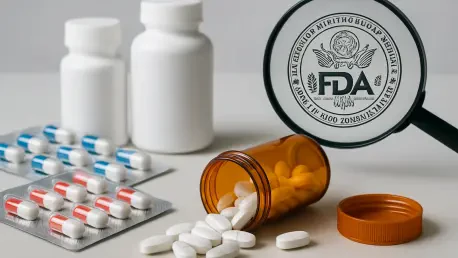In a landscape where over 50% of pharmaceuticals distributed in the US are manufactured overseas, the fragility of the drug supply chain has become a pressing concern for national health security, prompting urgent action. Imagine a scenario where a global crisis disrupts access to essential medications, leaving hospitals and pharmacies scrambling to meet demand. This vulnerability, underscored by past supply chain disruptions, has led the US Food and Drug Administration (FDA) to introduce FDA PreCheck, a strategic initiative aimed at bolstering domestic production. This market analysis explores how this program is poised to reshape the pharmaceutical industry by reducing reliance on foreign manufacturing, enhancing regulatory efficiency, and addressing critical security risks. The following sections delve into current trends, data-driven insights, and projections for the future of US drug supply chains.
Market Vulnerabilities: The Cost of Foreign Dependency in Pharmaceuticals
The US pharmaceutical market has long grappled with a heavy dependence on foreign manufacturing, driven by cost efficiencies and globalization. With only 11% of active pharmaceutical ingredient (API) manufacturers for FDA-approved products based domestically, the imbalance poses significant risks. Data highlights that supply chain disruptions, as seen during global health crises, can lead to shortages of critical drugs, impacting patient care and economic stability. This over-reliance is not merely a logistical issue but a strategic liability, as geopolitical tensions or trade interruptions could exacerbate access challenges. Understanding these vulnerabilities is essential to appreciating the market need for initiatives like FDA PreCheck, which aim to recalibrate the industry toward self-reliance.
Transitioning from the problem, the broader market context reveals a growing urgency to address these gaps. National security concerns have pushed policymakers to prioritize domestic production as a safeguard against external shocks. The pharmaceutical sector, valued at billions annually, faces increasing scrutiny from stakeholders who demand resilience alongside profitability. This backdrop sets the stage for analyzing how regulatory interventions are shaping market dynamics, particularly through innovative programs designed to incentivize US-based manufacturing while maintaining competitive standards.
FDA PreCheck Unpacked: A Catalyst for Domestic Manufacturing Growth
Structural Incentives: Navigating the Facility Readiness Phase
FDA PreCheck introduces a transformative two-phase approach to support domestic manufacturers, starting with the facility readiness phase. This stage emphasizes early collaboration between the FDA and companies during facility design and pre-production, allowing for the submission of detailed data via a type five drug master file. Market analysis suggests this structured engagement reduces regulatory uncertainty, a key barrier that has historically deterred firms from establishing US operations. While the upfront costs of compliance may challenge smaller players, the predictability offered could attract larger investments, potentially increasing the share of domestic API production over the next few years.
The implications for market growth are significant, as reduced uncertainty can translate into faster facility setups. Projections indicate that if even a modest percentage of manufacturers shift to domestic bases, the US could see a measurable uptick in local job creation and supply chain stability. However, the success of this phase hinges on the balance between regulatory support and the financial burden on companies, a dynamic that industry watchers will monitor closely as adoption unfolds.
Efficiency Gains: Streamlining Approvals in the Submission Phase
The second phase of FDA PreCheck, focused on application submission, targets the chemistry, manufacturing, and controls sections of drug applications through pre-application meetings and early FDA feedback. This streamlined process is expected to cut approval timelines, a critical factor in a market where speed to market often dictates competitive advantage. Current trends show that traditional approval delays can cost companies millions in lost revenue, so this efficiency could be a game-changer, particularly for generics and essential drugs.
Market forecasts suggest that faster approvals may encourage more firms to invest in US facilities, potentially shifting market share away from foreign-dominated segments. However, smaller manufacturers might struggle with the rigorous documentation requirements, which could limit the program’s reach unless paired with targeted support. This phase’s impact on market competition and drug pricing will likely become a focal point for analysis, as stakeholders assess whether efficiency gains translate into broader consumer benefits.
Security as a Market Driver: Health Resilience Over Cost
Beyond operational benefits, FDA PreCheck addresses a core market driver: the national security risks tied to foreign drug dependency. The pharmaceutical industry is increasingly viewed through the lens of health resilience, where uninterrupted access to medications during emergencies is paramount. Industry insights reveal that while domestic production may carry higher costs, the strategic value of self-sufficiency is gaining traction among policymakers and investors alike, reshaping market priorities.
This shift in perspective could redefine investment patterns, with projections indicating a potential rise in funding for US-based facilities over the next five years. Challenges remain, as cost competitiveness with foreign manufacturers is a persistent hurdle. Yet, the growing emphasis on security could spur complementary market mechanisms, such as government-backed incentives, to offset these disparities and drive long-term growth in domestic manufacturing capacity.
Emerging Trends: Regulatory Innovation and Market Transformation
The introduction of FDA PreCheck aligns with broader regulatory trends aimed at modernizing the pharmaceutical market. The FDA’s adoption of generative artificial intelligence (AI) across its centers signals a commitment to leveraging technology for enhanced efficiency, with early data showing improved review processes. Additionally, programs like the National Priority Voucher initiative, which slashes review times for select applications, reflect a market shift toward speed and adaptability, catering to national interests.
Looking ahead, market analysts anticipate that these innovations could catalyze a 10-15% increase in domestic manufacturing investments by 2027, assuming sustained policy support. The integration of advanced technologies and streamlined regulations may also lower entry barriers for new players, fostering competition. However, global trade dynamics and funding uncertainties could temper this growth, requiring agile strategies from both regulators and industry leaders to maintain momentum.
Another trend shaping the market is the rising demand for transparency and accountability in supply chains. Consumers and advocacy groups are pushing for clearer sourcing information, which could further incentivize domestic production as a trust-building measure. This evolving landscape suggests that regulatory programs like FDA PreCheck are not isolated efforts but part of a comprehensive market transformation, with ripple effects on pricing, innovation, and accessibility.
Reflecting on Market Impacts: Strategic Pathways Forward
Looking back, the analysis of FDA PreCheck reveals a pivotal shift in the US pharmaceutical market, addressing deep-seated vulnerabilities through regulatory innovation and a focus on domestic production. The program’s structured phases tackle critical barriers to market entry, while broader trends like AI integration and priority vouchers amplify the push for efficiency. These efforts underscore a growing recognition of health security as a market imperative, influencing investment and policy decisions.
For stakeholders, the insights offer actionable steps to capitalize on this momentum. Companies are encouraged to align with PreCheck guidelines early, leveraging FDA collaboration to streamline operations. Policymakers gain a framework to explore financial incentives that could level the playing field for domestic manufacturers. Meanwhile, the market as a whole stands to benefit from enhanced resilience, ensuring that future crises do not replicate past shortages. This strategic focus on building a robust, self-reliant supply chain marks a turning point, setting the stage for sustained growth and stability in the years ahead.









